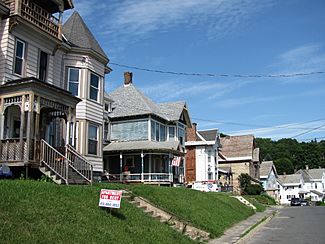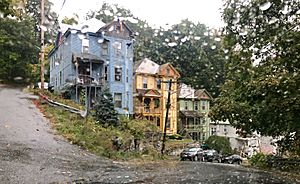Freeman's Grove Historic District facts for kids
Quick facts for kids |
|
|
Freeman's Grove Historic District
|
|

Bracewell Avenue (2010)
|
|
| Location | Roughly bounded by Liberty St., Eagle St., Bracewell Ave., and Houghton St., North Adams, Massachusetts |
|---|---|
| Area | 250 acres (100 ha) |
| Architect | various |
| Architectural style | Colonial Revival, Greek Revival, Late Victorian |
| MPS | North Adams MRA |
| NRHP reference No. | 85003388 |
| Added to NRHP | October 25, 1985 |
The Freeman's Grove Historic District is a special neighborhood in North Adams, Massachusetts. It's like a time capsule, showing how a working-class area looked in the late 1800s. This area grew a lot when factories were busy in the city.
The district includes many houses on Bracewell Street, Chase Avenue, and Hall Street. It also has some homes on Chase Hill and other nearby streets. The boundaries are roughly Liberty Street, Eagle Street, Bracewell Avenue, and Houghton Street. This historic district was added to the National Register of Historic Places in 1985. This means it's recognized as an important place to protect.
Contents
What Makes Freeman's Grove Special?
The Freeman's Grove neighborhood is located north of downtown North Adams. It sits on the hills that rise above the Hoosic River. The river flows from east to west through the city.
Homes from the Past
The houses in this district are a mix of different styles. You can see homes built for single families and also for multiple families. Most of these homes were built between 1887 and 1894. This was a time of fast growth in the area.
There are only a few houses that are older than this boom period. These older homes are mostly in the Greek Revival style. This style was popular in the early to mid-1800s.
Historic Eagle Street
Eagle Street forms the eastern edge of the district. It is a very old road that leads north from the city center. Some of the oldest buildings in Freeman's Grove are found on the west side of Eagle Street.
For example, the Haynes House at 175 Eagle Street was built around 1840. It is one of the biggest and most detailed houses in the district. Nearby, you can find two houses built in the Italianate style. One of these was built in 1889, which is quite late for that style.
Houses from Mail-Order Plans
Did you know some houses were built from plans ordered through the mail? A few homes in Freeman's Grove were built this way. The Stick style house at 39 Hall Street is one example. Its plans came from a book published in Tennessee.
Also, several duplexes in the district seem to be based on designs from Palliser, Palliser & Company. This company from Bridgeport, Connecticut, was famous for publishing house designs. It's interesting to think about how people built their homes long ago!




